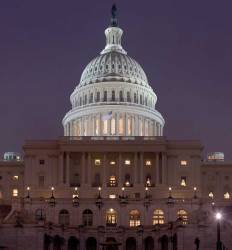Federal officials are working to fill a funding shortfall nearly certain to occur next year given that both the House and Senate have cut an already halved budget request for GPS civil funding.
Sources confirm the Federal Aviation Administration (FAA) and the Department of Defense (DoD) are in talks about finding money to make up for the dramatic reduction. One source familiar with the situation said the FAA was searching its accounts for resources to address the loss.
Federal officials are working to fill a funding shortfall nearly certain to occur next year given that both the House and Senate have cut an already halved budget request for GPS civil funding.
Sources confirm the Federal Aviation Administration (FAA) and the Department of Defense (DoD) are in talks about finding money to make up for the dramatic reduction. One source familiar with the situation said the FAA was searching its accounts for resources to address the loss.
The FAA, which was designated by the White House as the funding arm for all civil agencies, is supposed to pay for that portion of the GPS modernization program meant to improve service for civil users. The money supports the new L1C civil signal and the monitoring of civil signals.
“FAA will find some money,” said another expert source, “(although) it will be nowhere near what they promised to give.”
The civil funding was “zeroed out,” that is, eliminated entirely, by the House this year and slashed by $5 million or 25 percent by the Senate. Although congressional conferees still have to settle on a final number, there appears to be little chance of any increase. A congressional staffer told Inside GNSS earlier this year that the cuts were made to reach spending targets.
"The Department of Transportation works very closely with the Department of Defense, and in particular the Air Force GPS Directorate, on managing the financial resources needed to support implementation of the new L1C signal onto the GPS Block III satellites," a Department of Transportation (DoT) spokesman told Inside GNSS. "This includes the incorporation of civil signal performance monitoring into the next generation operational control segment (OCX). We do not have any evidence of funds being misspent."
GPS civil advocates might have had more wiggle room, but the White House asked for only $20 million for fiscal year 2014 — less than half of the amounts requested in each of the previous four years. This is despite the fact that the civil community was already more than $70 million behind on its mandated support — an amount that could potentially slow the modernization.
The cuts are just the latest in a series of fiscal reversals. The White House submitted a request for between $40 million and $60 million each fiscal year since 2010. The 2010 budget request of $43.4 million was fully funded but each subsequent year saw dramatic cuts. The White House’s request and final budget in 2011 were $58.5 million and $38.4 million respectively. In 2012 and 2013 Congress allocated only $19 million though the requests were, respectively, $50.3 million and $40 million.
Funds Spent on Wrong GPS Improvements?
Even if Congress were to approve a request of $40 million or $50 million, it still might not be have been enough. Sources confirmed that the money provided thus far by the FAA has not all gone to the portions of the GPS modernization effort that the agency expected it to.
Apparently some confusion arose over exactly what the money was supposed to pay for, sources told Inside GNSS. The misunderstanding may stem from the fact that multiple civil signals have been developed, although some, such as L5, are being funded by the Air Force, said one source. Although the Air Force is tasked with paying for putting the L5 signal into service, some room remains for interpretation on who should underwrites its monitoring.
Asked whether the civil side is being asked to make up for misspent funds, the DoT spokesman said only, "DoT and DoD are working closely together to ensure the needs of both the civil and military GPS communities are addressed."
The situation was further complicated by delays as the FAA worked through its civil GPS signal-monitoring requirements. In the meantime, the Air Force held on to some of the funds, but that triggered congressional criticism. In fact, the unspent money was cited as the reason for cuts the last two years.
Whatever sparked the decisions, sources said the Air Force spent some of the civil money on elements of GPS modernization other than L1C and civil signal monitoring. The sources were not able to say where the money was spent, but suggested it benefited both civil and military users.
Whatever the benefits, defense officials are now looking to the FAA and the Department of Transportation to make up the shortfall created when the money was redirected. It is not clear how much more is needed.
Neither the Air Force nor the FAA responded to requests for comment by press time.
Fiscal Bonds of Sequestration
Ironically, the situation might be improved, at least for a while, if the gridlocked Congress is forced again this year to pass a continuing resolution — a short-term funding fix to keep the government open after the end of the fiscal year on September 30. If that happens then the civil GPS spending could continue at this year’s level of $19 million.
“There is virtually no chance of coming to an agreement on all of the individual appropriation,” said Stan Collender, national director of financial communications for Qorvis Communications, a large Washington, D.C. public relations agency that represents a variety of clients affected by federal budget decisions. “The only question is whether they will be able to get a continuing resolution [CR] that agrees on a specific level before the fiscal year begins.”
A CR is fraught with pitfalls, however, Collender pointed out. If it is set at the current level, as has been done in the past, the CR would put the federal budget over the spending cap and trigger another year of sequestration — or automatic, across-the-board reductions.
“You are in sequestration only if the appropriations for 2014 exceed the spending caps,” Collender explained. “It is a process that can occur each year for 10 years, if Congress and the White House appropriate more than the spending cap for that year.” The current level of spending is about $90 billion more than the spending cap, which would mean approximately a $45 billion cut in both defense and civil budgets.
Making matters worse, Collender said, is that the sequestration is unlikely to kick in until two weeks after January 3, the last possible day of the congressional session. This means that the cuts would have to be absorbed over the remaining 9 months of the 2014 fiscal year instead of the full 12.
And the need will arise again this fall to agree on raising the debt ceiling and renew a number of other one-year measures.
“So everything happens kind of like last year — a fiscal cliff around the middle of January,” Collender told Inside GNSS, a recurring situation he finds depressing.






